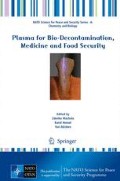Abstract
The safety of packaged food and medical devices is a major concern to consumers and government officials. Recent inventions (PK-1 and PK-2) based on the principles of non-thermal, atmospheric plasma has shown significant reduction in bacterial contamination inside a sealed package. The objective of this study was to evaluate the PK-1 and PK-2 systems in the reduction of Bacillus subtilis spores using packages containing air or modified atmosphere (MA) gas (65% O2/30% CO2/5% N2). The experimental design consisted of the following parameters: (1) two voltage conditions: 13.5 kV with 1.0 cm electrode gap (PK-1) and 80 kV with 4.5 cm electrode gap (PK-2), (2) two treatment conditions: inside and outside the field of ionization, (3) PK-1 and PK-2 optimized treatment times: 300 and 120 s, respectively, and (4) two package gas types: air and modified atmosphere (MA) gas (65% O2/30% CO2/5% N2). Measurements included: (1) bacterial reductions of Bacillus subtilis var. niger (B. atrophaeus), (2) ozone, nitrous oxides (NOx), and carbon monoxide concentrations, and (3) relative humidity. Bacillus subtilis (1.7 × 106/strip) were loaded into sterile uncovered petri dishes and treated with ionization generated in packages using air or MA gas blend. Samples were treated for 300 s (PK-1) or 120 s (PK-2) and stored at room temperature for 24 h. Results documented relative humidity (RH) ranged from 20% to 30%. After 300 s of PK-1 treatment (13.5 kV/44 W/1.0 cm gap), ozone concentrations were 6,000 ppm (air) and 7,500 ppm (MA). After 120 s of PK-2 treatment (80 kV/150 W/4.5 cm), ozone concentrations were 7,500 ppm (air) and 12,000 ppm (MA). Ozone and NOx concentrations were non-detect (ND) after 24 h. PK-1 carbon monoxide levels were <20 ppm (air) and <100 ppm (MA) after 24 h. The PK-2 carbon monoxide levels were <20 ppm (air) and <400 ppm (MA) after 24 h. Treatments showed reductions in spores of greater than 6 log10 after 24 h. Reductions were maintained without additional re-growth at 72 h. These results indicate that the PK-1 and PK-2 systems have the capacity to reduce Bacillus subtilis spores in an in-package ionization process.
Access this chapter
Tax calculation will be finalised at checkout
Purchases are for personal use only
References
Ramos E (2008) Use of non-thermal, atmospheric-pressure plasma for reduction of bacterial food pathogens. Master of Science thesis, Southern Illinois University, Carbondale, IL USA
Sohbatzadeh F, Hosseinzadeh A, Mirzanejhad C, Mirzanejhad S, Mahmodi S (2010) E. coli, P. aeruginosa, and B. cereus bacteria sterilization using afterglow of non-thermal plasma at atmospheric pressure. Appl Biochem Biotechnol 160:1978–1984
Gaunt LF, Beggs CB, Georghiou GE (2006) Bactericidal action of the reactive species produced by gas-discharge nonthermal plasma at atmospheric pressure: a review. IEEE Trans Plasma Sci 34(4):1257–1269
Deng X, Shi J, Kong MG (2006) Physical mechanisms of inactivation of Bacillus subtilis spores using cold atmospheric plasmas. IEEE Trans Plasma Sci 34(4):1310–1316
Deng S, Ruan R, Mok CK, Huang G, Lin X, Chen P (2007) Inactivation of Escherichia coli on almonds using nonthermal plasma. J Food Sci 72:M62–M66
Vojkovska H, Slamova J, Kozakova Z, Krcma F (2010) Sterilization effect of dielectric barrier discharge on eukaryotic microorganisms. In: 25th summer school and international symposium on the physics of ionized gases Donji Milanovac, Serbia, Publication of Astron Obs Belgrade No. 89, pp 331–334, 30 Aug–3 Sept 2010
Trompeter F, Neff WJ, Franken O, Heise M, Neiger M, Liu S, Pietsch GJ, Saveljew AB (2002) Reduction of Bacillus subtilis and Aspergillus niger spores using nonthermal atmospheric gas discharges. IEEE Trans Plasma Sci 30:1416–1423
Klockow P, Keener KM (2009) Safety and quality assessment of packaged spinach treated with a novel ozone generation system. Lebensm Wiss Technol 42(6):1047–1053
Johnson FM (2004) Atmospheric plasma inactivation of foodborne pathogens on fresh produce surfaces. MS thesis, University of Tennessee-Knoxville, TN
Connolly J, Mosnier JP, Valdramidis V, Byrne E, Cullen PJ, Keener KM (2010) Diagnostic of reactive species in a dielectric barrier discharge air/helium plasma for the treatment of a pre-packed food simulant. In: 37th EPS conference on plasma physics, Dublin, Ireland
DIFCO Manual (1984) Difco manual of dehydrated culture media and reagents for microbiological and clinical laboratory procedures, 10th edn. Difco Laboratories, Detroit
Dobrynin D, Fridman G, Mukhin YV, Wynosky-Dolfi MA, Rieger J, Rest RF, Gutsol AF, Fridman A (2010) Cold plasma inactivation of Bacillus cereus and Bacillus anthracis (Anthrax) spores. IEEE Trans Plasma Sci 38(8):1874–1884
Author information
Authors and Affiliations
Corresponding author
Editor information
Editors and Affiliations
Rights and permissions
Copyright information
© 2012 Springer Science+Business Media B.V.
About this paper
Cite this paper
Keener, K.M. et al. (2012). Decontamination of Bacillus subtilis Spores in a Sealed Package Using a Non-thermal Plasma System. In: Machala, Z., Hensel, K., Akishev, Y. (eds) Plasma for Bio-Decontamination, Medicine and Food Security. NATO Science for Peace and Security Series A: Chemistry and Biology. Springer, Dordrecht. https://doi.org/10.1007/978-94-007-2852-3_34
Download citation
DOI: https://doi.org/10.1007/978-94-007-2852-3_34
Published:
Publisher Name: Springer, Dordrecht
Print ISBN: 978-94-007-2851-6
Online ISBN: 978-94-007-2852-3
eBook Packages: Biomedical and Life SciencesBiomedical and Life Sciences (R0)

